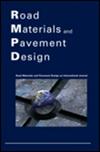基于数字图像处理技术和加速路面试验的沥青路面纹理三维模型重建与演化
IF 3
3区 工程技术
Q2 CONSTRUCTION & BUILDING TECHNOLOGY
引用次数: 0
摘要
摘要沥青路面表面纹理是影响路面功能的主要因素。为了准确揭示沥青路面纹理的演化特征,需要对沥青路面表面纹理进行重建,以进行路面性能和质量评价。利用数字图像处理技术和加速路面测试系统,重构优化后的沥青路面表面纹理三维模型,并研究其演化特性。首先,利用三个相机参数及其阈值对沥青路面表面纹理三维模型进行优化。其次,利用加速路面试验系统模拟交通荷载作用下的密级配沥青混合料路面纹理演化特性。最后,建立了沥青路面表面纹理演变的预测模型。结果表明,优化后的路面纹理三维模型与实际路面结构相似。沥青路面表面纹理演化特征可分为3个时期和6个阶段。该演化模型能较准确地描述沥青路面表面纹理的演化过程。MLS11:加速路面测试系统;HP:平均像元差;Df:分形维数;MTD:平均纹理深度;关键词:沥青路面表面纹理;数字图像处理技术;路面加速测试;项目资助:中央高校基本科研业务费专项资金(项目编号:300102212906)[批准号:300102212906];陕西省创新能力支撑计划[批准号2022TD-07];国家自然科学基金项目(51908460)[批准号:51908460]。本文章由计算机程序翻译,如有差异,请以英文原文为准。
Reconstruction and evolution of 3D model on asphalt pavement surface texture using digital image processing technology and accelerated pavement testing
AbstractAsphalt pavement surface texture is the main factor affecting pavement function. Reconstruction of the asphalt pavement surface texture is needed to accurately reveal its evolutionary characteristics for pavement performance and quality evaluation. To reconstruct an optimised 3D model of the asphalt pavement surface texture and to study its evolutionary properties, digital image processing technique and accelerated pavement testing system were used. First, the asphalt pavement surface texture 3D model optimised by three camera parameters and their thresholds. Next, the accelerated pavement testing system simulated traffic loadings on dense-gradation asphalt mixtures to investigate the pavement surface texture evolution properties. Finally, predictive models are developed for the asphalt pavement surface texture evolution. Results show that the optimised pavement texture 3D model resembles actual pavement structure. The surface texture evolutionary characteristics of asphalt pavement can be divided into three periods and six stages. The evolution model can accurately characterise the evolution of the surface texture of asphalt pavement.Abbreviations: MLS11: Accelerated pavement testing system; HP: Mean pixel difference; Df: Fractal Dimension; MTD: Mean Texture Depth; BPN: British Pendulum NumberKEYWORDS: Asphalt pavementsurface texturedigital image processing technologyaccelerated pavement testingevolutionary characteristics Disclosure statementNo potential conflict of interest was reported by the author(s).Additional informationFundingThis work was supported by Fundamental Research Funds for the Central Universities, CHD under project No. 300102212906: [Grant Number 300102212906]; Innovation Capability Support Program of Shaanxi: [Grant Number 2022TD-07]; National Natural Science Foundation of China under project No. 51908460: [Grant Number No. 51908460].
求助全文
通过发布文献求助,成功后即可免费获取论文全文。
去求助
来源期刊

Road Materials and Pavement Design
工程技术-材料科学:综合
CiteScore
8.10
自引率
8.10%
发文量
105
审稿时长
3 months
期刊介绍:
The international journal Road Materials and Pavement Design welcomes contributions on mechanical, thermal, chemical and/or physical properties and characteristics of bitumens, additives, bituminous mixes, asphalt concrete, cement concrete, unbound granular materials, soils, geo-composites, new and innovative materials, as well as mix design, soil stabilization, and environmental aspects of handling and re-use of road materials.
The Journal also intends to offer a platform for the publication of research of immediate interest regarding design and modeling of pavement behavior and performance, structural evaluation, stress, strain and thermal characterization and/or calculation, vehicle/road interaction, climatic effects and numerical and analytical modeling. The different layers of the road, including the soil, are considered. Emerging topics, such as new sensing methods, machine learning, smart materials and smart city pavement infrastructure are also encouraged.
Contributions in the areas of airfield pavements and rail track infrastructures as well as new emerging modes of surface transportation are also welcome.
 求助内容:
求助内容: 应助结果提醒方式:
应助结果提醒方式:


